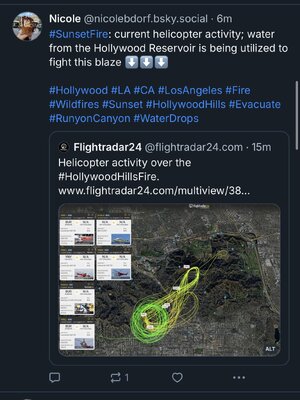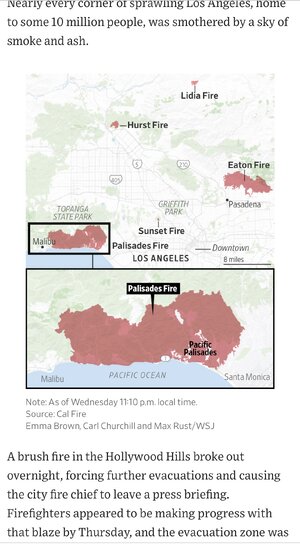“… By 3 a.m. Wednesday, all water storage tanks in the Palisades area “went dry,” diminishing the flow of water from hydrants in higher elevations, said Janisse Quiñones, chief executive and chief engineer of the Los Angeles Department of Water and Power, the city’s utility.
“We had a tremendous demand on our system in the Palisades. We pushed the system to the extreme,” Quiñones said Wednesday morning. “Four times the normal demand was seen for 15 hours straight, which lowered our water pressure.”
…
Quiñones and other DWP officials said that the city was fighting a wildfire in hilly terrain with an urban water system, and that at lower elevations in Pacific Palisades, water pressure remained strong.
Before the fire, all 114 tanks that supply the city water infrastructure were completely filled.
Quiñones said that the hydrants in the Palisades rely on three large water tanks with about 1 million gallons each. The first ran dry at 4:45 p.m. Tuesday; the second at 8:30 p.m.; and the third was dry at 3 a.m. Wednesday.
“Those tanks help with the pressure on the fire hydrants in the hills in the Palisades, and because we were pushing so much water in our trunk line, and so much water was being used. ... we were not able to fill the tanks fast enough,” she said. “So the consumption of water was faster than we can provide water in a trunk line.”
In other words, the demand for water at lower elevations was hampering the ability to refill the tanks located at higher elevations. Because of the ongoing fire, DWP crews also faced difficulty accessing its pump stations, which are used to move water up to the tanks.
… It’s unclear how widespread the hydrant issues were. In November,
the lack of water from hydrants hurt the effort to combat the Mountain fire in Ventura County, when two water pumps became inactive, slowing the process to deliver hillside water.
…
Caruso, who also
ran unsuccessfully for mayor in 2022, contended that the challenges were avoidable.
“This is a window into a systemic problem of the city — not only of mismanagement, but our infrastructure is old,” Caruso said. …”
Firefighters battling the Palisades fire dealt with hydrants that had little to no water flowing out. By 3 a.m. Wednesday, all hydrants 'went dry,' an LADWP official says.

www.latimes.com
——
Several things seem to be true at once. There are valid reasons why extreme circumstances taxed water pressure during this crisis. But also the infrastructure requires a major overhaul in the face of increased pressure of these kinds of fires happening regularly with increased intensity in more densely populated areas.








